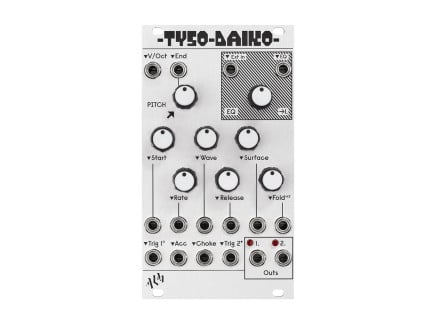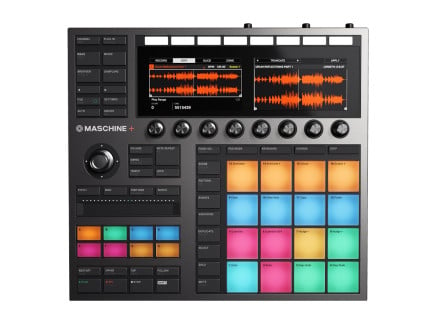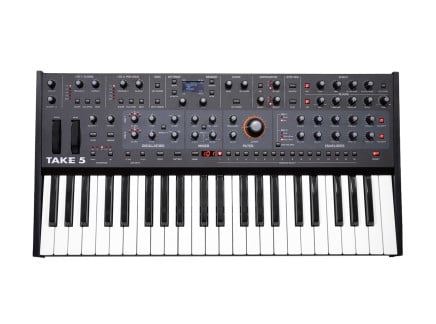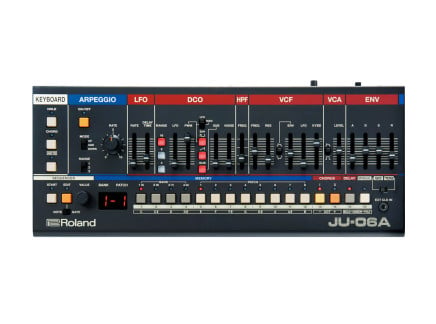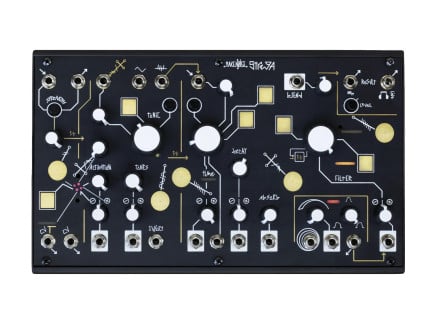We're continuing our year in review, this time asking another group of our favorite artists and content creators what their favorite gear of the year was. They didn't restrict their answers to strictly brand new gear...instead, they revealed the most inspiring instruments they personally acquired this year, ranging from hot-off-the-presses new releases to long-standing favorites.
Be sure to check out our recent articles with additional artist picks and staff picks as well; and of course, we'd like to thank Red Means Recording, Noir et Blanc Vie, Knobs, BoBeats, Starsky Carr, Liam Killen, and OoraMusic for their contributions to our year-end wrap-up. So without further delay, let's dig in!
Red Means Recording's Pick: Patching Panda Ephemere
Composing with control voltage can be an enjoyable experience, but sometimes looping complex modulations or sequences on the fly can be tricky. Well, it used to be tricky thanks to the Ephemere from Patching Panda, a two-channel CV and Audio recorder. Giving you the opportunity to grab choice bits of modulation or sequence data, Ephemere lets you play with voltage in a fun and unique way. With an intuitive interface and a crisp OLED display that begs you to gaze upon its glory, this handy tool can become a vital part of your next composition or sound piece. In fact, it seems that Red Means Recording has recently discovered many of the possibilities that such a device presents.
Free from deep menu diving, the Ephemere is straightforward: patch a CV source to the Input, hit Record, and you have a recorded CV free for you to loop either in whole or just small sections. You can select the resolution, which ranges from four seconds at 44.1 kHz, 16-bit resolution or up to 1074 seconds (~18 minutes) at 172 Hz sampling rate. This is great for melodic lines, sequences, or random voltages to give you an extra bit of variation, especially when limiting the loop window and using the Scan knob and CV input. With the Speed control, you can also create musical divisions of up to 5x and down to 1/5 the original speed.
Ephemere also works as an audio looper, letting you grab 4s of 44.1k audio. Use the controls to dial in short loops, slow those down, speed them up, and scan through at your recording. By slowing it down, you can get nasty, aliased sounds which is handy for creating unique pads and textures. You can decrease the fidelity of the initial recording for noisier and longer samples which can be synced to a clock or synced modulation source.
Tools like the Ephemere are incredibly useful for composing and sound design giving you intense control over the control voltage. Not only that, you can store any waveform you want with the built-in SD card reader letting you easily move between different melodies, modulation waves, or audio files. Maintain a sense of uncertainty, while regaining a bit of control, and have a whole lot of fun while doing it. That's the stance of Ephemere.
Knobs's Pick: ALM Tyso Daiko
We've talked to Knobs in the past, learning more deeply about his interest in both effect pedals and modular synthesis. We were happy to learn that his favorite new piece of gear was also one of our own: expanding from the Dinky's Taiko, the Tyso Daiko is a similarly spirited 12-bit drum voice that just sounds great and is fun to play with. Comprising two voices that can be independently triggered, the Tyso is capable of creating complex drum sounds and works amazingly well as a synth voice. There are parameters that affect the two voices differently, but the core sounds change the voices simultaneously. This makes creating realistic drum sounds easy by adding subtle changes between each hit using the many CV inputs, while maintaining cohesiveness.
On the top, there's a built in tilt EQ that will emphasize highs or lows of the first voice depending on the knob position. An easy trick is to patch Voice 2 into the Ext. In which mixes it with Voice 1 in the EQ, letting you create rich textures. There's even CV control for the control knob for a nice organic feel. While the EQ is normalized to function with only Voice 1, Voice 2 has its own discrete parameter, too: the Fold control. This introduces a bit of dirt to the voice by wavefolding the signal. Both Voices are affected differently by the Accent input, with Voice 1's Release time doubling and Voice 2's halving.
Both voices share the same bank of 11 waveforms moving from noise, through classic waveforms, bell-like, vocaloid, and everywhere in between. To mimic the acoustic properties of drums, a two stage pitch envelope is built in letting you sweep up or down in pitch with the Start and End knobs. The Rate has its own control with a minimum turning it off and the maximum giving you slow sweeps. Both voices have their own pitch sweep independently triggered, allowing you to get some truly spacey sounds.
Whether you're all-in on drum synthesis or this would be your first foray into the world of percussion, the Tyso Daiko is a great addition to your rack. It is also incredibly capable of acting as a melodic synth voice with a very musical envelope. ALM is known for great modules and this is no exception.
BoBeats's Pick: Native Instruments Maschine+
Having the creative and manipulative power of a computer without using a computer is quite hard to achieve, and yet Native Instruments made that concept a reality with their fantastic Maschine+. Already a hit as a mini-DAW, drum sequencer, and performance & production controller, Maschine has been one of the most highly-rated and sought after production and beat making tools for the past 11+ years. Version after version, NI really hit it out of the park with the MkIII iteration with OLED displays, audio I/O, performative touchstrip, and an overall better build quality. Expanding upon that by making Maschine self-sufficient and fully independent from the computer, we can understand why Maschine+ was BoBeats's favorite piece of gear for the year!
Looking at the Maschine+'s internal software alone, you have a healthy amount of tools for sound designing and mixing any kind of material you throw at it. On top of all the amazing Maschine instruments, samples, and effects, you also have access to some of NI's amazingly renowned soft synths and effect plugins for even further sonic creation. One of the most amazing instruments inside of Maschine+ is the sampler, and with the inclusion of two line inputs and one dynamic mic input, you can sample external sources directly into Maschine+ without the immediate need for an audio interface. Of course, with the two USB host ports and the SD slot, you have room for not only expanding your audio I/O capabilities, but also project and sample storage as well as room for bringing in external MIDI gear such as keyboards and fader/knob controllers.
Performing and producing on Maschine+ is a cinch with the amount of control you're presented, including velocity and pressure sensitive RGB pads, robust and smooth knobs, as well as a flexible and multi-faceted touch strip. Maschine+ offers a multitude of ways for entering notes and parameter changes, be it per step, live recorded, or even different pad and performance modes, such as keyboard, chord, step, and many more. For further detail, the OLED screens let you see all the details of the Maschine sequencer for easy and precision editing. Easily create patterns to sequence into fully fledged tracks, and mix them on the fly in the mixing view, great for balancing levels, panning, and creating sends and returns. Group your instruments and tracks into eight easy to access groupings, represented by the buttons A through G, and if you need more, Maschine+ can always create additional groups for your personal needs.
If you need more control or want to take your projects to your other DAW for further production or mixing, Maschine+ works immediately with the Maschine software on your computer. Hook your Maschine+ up to a speaker system to perform your tracks in the club, on stage, or even while busking with the provided balanced line outputs. As long as you have a solid power source, a pair of headphones, and some musical inspiration, Native Instrument's Maschine+ brings you some of the highest quality of production and beat making while in the studio or on the go.
Starsky Carr's Picks: Waldorf M + Sequential Take 5
With all of the neat synths that came out this year, anyone would be hard pressed to pick just one favorite. So in narrowing it down to just two, Starsky Carr's picks are the Waldorf M and Sequential Take 5. Both instruments look back on the history of their respective brands as premier designers of wavetable and analog synthesizers, respectively, but reimagined in a modern package.
The Waldorf M draws upon a rich legacy of wavetable instruments, including the PPG Wave and Waldorf's own Microwave. In fact, it comes from the factory with a number of the same original wavetables from those instruments, but they see a new lease on life with all of the modern enhancements that M provides. With oscillators that can behave like the classic Microwave 1 or more modern Microwave II/XT, a true analog filter based around the SSI 2144 chip, a stereo VCA, and a number of LFOs and envelope generators, M delivers on its promise for traditional, wavetable synthesis workflows.
But where M breaks new ground is in its flexibility as a powerful performance and recording instrument, including its capabilities as a four-part, multitimbral instrument. Its eight-voice polyphony may be split across the four parts in any possible combination, meaning you could devote five voices to flourishing pads, while leaving one each available for leads, basses, and textural sounds, or construct elaborate timbral counterpoint between parts. Plus, in addition to its main stereo outputs, M provides four assignable auxiliary outputs, meaning that you could easily multi-track all four parts. Add in the performance arpeggiator with a number of playback patterns, and you have a highly capable instrument drawing from the legacy of some of the most beloved wavetable synths of all time.
Fresh off of their reissue of the Prophet-5, Sequential's Take 5 encapsulates a lot of similar concepts in a package that is comparatively much more affordable. Five voices, each having two VCOs paired with the same rich filter from the Prophet-5, combined with effects, an arpeggiator, and sequencer make the Take 5 a synth that easily holds its own when compared with other two or three times its price. But features aside, it simply sounds full, lush, and really good, just as we'd hope any good analog polysynth to be.
But Take 5 has a few other tricks up its sleeve, further solidifying its status as a small but mighty synthesizer. Like Sequential's other recent instruments, the beloved Vintage knob makes another appearance here, allowing you to dial in those subtle quirks which might be found on the synths of yesteryear. And if you find yourself missing the extended range sacrificed by the Take 5's slim 44-key format, the handy Low Split feature allows the keyboard to be divided into two zones, of which the lower one may be dropped down another octave or two from the other. While it's not the same as having a 61 or 88-note keyboard, the additional range is certainly appreciated.
Whether you're a die-hard analog devotee or fully embrace the digital revolution, Take 5 and M just might be one (or both) of the things you're looking for.
Liam Killen's Pick: Roland Boutique JU-06A
It's hard to beat simplicity, especially when it sounds great, and that's precisely why Liam Killen picked the Roland Boutique JU-06A for his favorite synth of 2021. Being a huge fan of the Juno synths myself, and having spent a lot of time with them as well, I can attest that the JU-06A is probably the best and most affordable way to get that authentic Juno experience today. Visually, the JU-06A harkens back to the colorful aesthetic of the Juno-60, but it actually combines features from both the 60 and the Juno-106, perhaps making this the definitive member of the classic Juno family.
Compared to a lot of its peers, even within the Boutique family, the JU-06A is a rather straightforward instrument. But what it lacks in features it more than makes up for in sounding rather incredible—in fact, you usually have to go out of your way to make a Juno sound bad. All the basic sonic building blocks are here: an LFO, one DCO per voice with pulse, sawtooth, and sub-square waveforms, highpass and resonant lowpass filters, VCA, and ADSR envelope generator. But with the classic Juno synths, the chorus effect is what really brings things to life, and on the JU-06A you have the option of choosing the 60 or the 106 version of the chorus. Roland has also added a delay effect, meaning that you no longer have to rely upon external effects to give arpeggios and sequences a bit more dimension to them.
The original Juno-60 featured an arpeggiator, which was removed from the 106 in favor of MIDI control, but now with the JU-06A, you get both. In fact, there's even an onboard sequencer, meaning that the JU-06A offers nearly everything you need to craft excellent sounds and musical ideas within the synth itself. But like any Juno, it plays nicely with other instruments, too, and could be a compact addition to any studio or hardware-based performance rig. Should you find yourself craving the beloved sound of Roland's early analog polysynths, complete with the swirling chorus and all, JU-06A will certainly get you there.
Noir et Blanc Vie's Pick: Instro Saïch
Instruo's Saïch is a powerful and clever module: it packs four saw oscillators behind a simple set of macro controls, great for producing everything from super saws and detuned oscillator clusters to chords, arpeggiated harmonies, and complex noise textures. According to Instruo's site, "Saïch" is a term borrowed from natural sciences, meaning "a number of animate things massed together in motion." Given its functionality, this is a quite lovely name; its strengths are in creating swarming textures with unified movement. This is the nature of our friend Noir et Blanc Vie's interest in it: it provides a simple, straightforward layout for producing chords, harmonic movement, and rich beds of analog sound.
Saïch features a single 1V/Oct input shared between its four oscillators, and three additional 1V/Oct inputs for oscillators II, III, and IV, respectively. Oscillators II, III, and IV also offer individual detune potentiometers, making it easily possible to dial in everything from swarm monophonic lines to seemingly independent behavior between its oscillators (given the right CV source!). The oscillators can be globally frequency modulated (with a choice of linear or exponential FM), and Oscillator I can be switched into Sub oscillator mode, with options for saw, pulse, and continuously pulse-width modulated pulse shapes.
It's important to note that Saïch has only one audio output that produces a sum of all of its oscillators. Saïch's most interesting feature, though, is the multi-function slider located at the bottom of the module. This slider can be used in a wide range of ways...but in performance, it is typically used as a "smart VCA" with seven "mix profiles." In one mix profile, for instance, all oscillators' volumes are scaled linearly with respect to the slider; however, in other modes, moving the slider results in patterns of crossfades or hard cuts between individual oscillators and/or combinations of oscillators. This means that with a single slider (and corresponding CV input) you can accomplish chordal movement, arpeggios, crossfading, or simple VCA-like behavior. Paired with the right multi-output quantizer (Harmonaig, for instance?), this becomes an easy way to create quite complex textural and harmonic movement...offering yet another clever take on polyphony in modular synths. Suddenly, that single audio output doesn't seem like a limitation at all.
The multi-function slider and Ctrl CV input can also be mapped to produce specific intervallic offsets for each oscillator as well...and a dedicated Diatonic mode makes it easily possible to create a wide range of chords via the 1V/Oct and Ctrl CV inputs. And there's much more to it than just all that...but suffice to say, if you want huge-sounding bass lines, THX-like pitch spread, or a sound source for making dense chords, Saïch can do what you need.
OoraMusic's Pick: Make Noise Strega
The inclusion of Make Noise's Strega in this list shouldn't be a surprise...it's a current favorite synth of our own as well. Given its unique brand of chaos and tactile performability, it's found a home in many setups over the year, including OoraMusic, to whom it presents unique potential as a source of rich, noisy drones and textures.
Perhaps the most compelling aspect of Strega is simply is peculiarity: by presenting users with a peculiar, non-standard signal flow and a somewhat cryptic user interface, it becomes nearly impossible to rely on your own synth "habits" and creative impulses. Instead, you need to get to know Strega's own personality over time, gradually learning how controls interact with one another and how its overall nonlinearites can unfold into compelling, unpredictable gestures and textures. Strega is an instrument that rewards careful listening and subtle changes, often making you reconsider your own approaches to music altogether.
We've said it before, and we'll say it again: if you're looking for an instrument with a load of character, an instrument capable of thick drones and distant melodies, an instrument ideal for noise improvisation, or simply an instrument to help open your ears, Strega is sure to be a promising pick.
In Review
It should be clear by now that this year has been rich with new gear, and artists finding inspiration in instruments both new and old. And while there's still some year left yet, we've had a blast taking time to think about our favorite parts of 2021, from Make Nois + Alessandro Cortini's spectacular Strega to the pint-sized Prophet-esque Sequential Take 5. And of course, we've been thrilled to face the reminder that, in actuality, the newest gear isn't necessarily the best, and it's still possible to find new inspiration in a familiar instrument.


